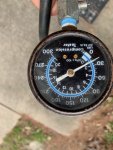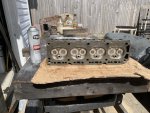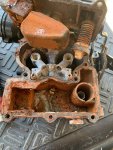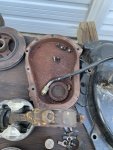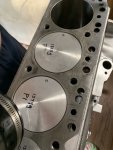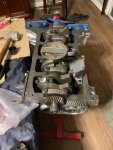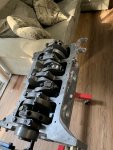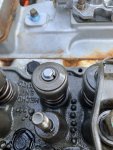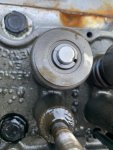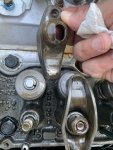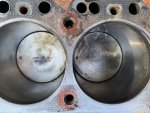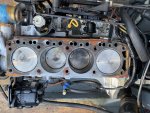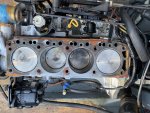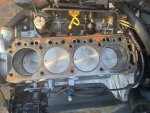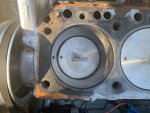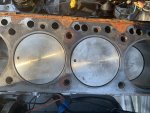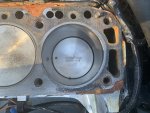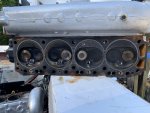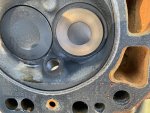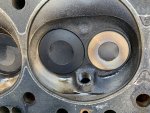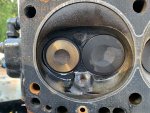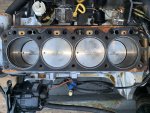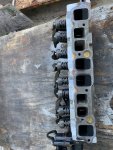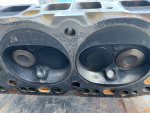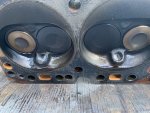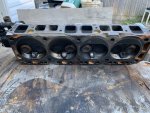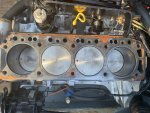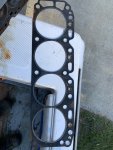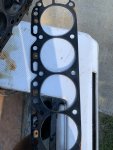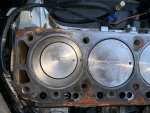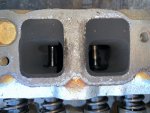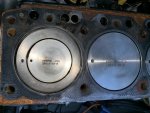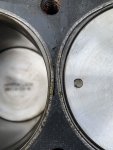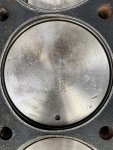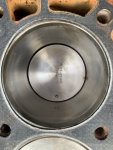T4Frog
Seaman Apprentice
- Joined
- Sep 15, 2019
- Messages
- 30
Hello all. Many thanks for outstanding advice over the past 4 months, especially to those sharing their wisdom. I decided to take on my first engine complete rebuild for an engine that upon internal inspection should have been scrapped, and wanted to do it by the book. Mercruiser 3.0L had sat idle for 5 years filled with rain water in places water should never be. It was winterized properly, while I was up north, but the boat was not covered allowing water to freeze and get in through the dip stick which started the problem (winter 2013).
In spring 2016 I changed the oil, outdrive impeller and with carb manipulation, got it to run/i looping and rough, concluding it was the sketchy carb. (turned out It was heavy pitting in the 2, 3, &4 cylinder walls).
May 30, 2019, I pulled the engine, free'd the stuck piston rings, found cyl.1-4 psi's of 60, 50, 40, & 25 (more water in the compression chambers back to front from the boat/engine tilt, along with a rusted through front cover. Read a thread for advisement and found that the coolant system held 30psi for 40 minutes before I bled it down and decided to put time into her. When I opened the engine up, the amount of rust top to bottom with rust stalactites hanging off the crank was something to see.
400 backyard man hours, $2100 in parts, $300 for the machine shop tank, bore, hone, and pistons press on later, I took her out for a test run break in. PSI's were now 193, 192, 190, 192. I had bench run, and in the backyard boat run the engine for a total of about an hour at low rpms (1000 or less), working out the bugs and getting the idle, shift, etc., set. It was bay test run day(eve) 9/14/2019 at 7pm. Had the wife steering for 15 minutes from the marina to the bay at 1200-2000 rpms and all was good. Chesapeake Bay was rough and filling nearing high tide 3-4' surge. I took over at 2000 rpms increasing to 3000 rpms over 10 minutes at dusk before deciding to turn back to beat nightfall just in case. All was running beautifully, with a new 14.25x21 aluminum prop, a steady engine temp of 170, and a very smooth running completely open for viewing engine. Five minutes running back about 3/4 mile off the coast against the surge, my boat hung up and rpms went from 3400 to 1000 at 3/4 throttle. I immediately cut her off, tilted the outdrive, although it was getting dark saw the un-fowled prop. I went to start and could not less sputtering. I am a back up plan guy and mounted my old outboard Johnson 15 long shaft as a kicker just in case. That kicker saved our asses at about 10 mph for 30 minutes on the transit back.
When I trailered her and got home about 8:30pm, I went to clean the boat and saw all 3 blades had rebar dents, the anode disc plate had been torn off, the cavitation plate was bent, and the alpha outdrive paint was scratched up in front of the prop. The notorious high tide submerged Chesapeake Bay crab pot had struck again!
Here's where I'm at this morning. Oil is pristine. Pulled the distributor, gear teeth Look good. pulled the plugs, compression test 1-4, 191, 10, 190, 190. I camera inspected cylinder 2 and from what I can make out, cylinder walls look good. piston top looks good and travels with a very small amount of build up, valves and head were difficult to see with todays bright sun but are opening/moving. I hear no clicking while cranking with plugs out, nor did I notice a loud noise upon engine dying on the water. plugs look great.
I'm trying the least involved process of elimination and need some guidance. I'm not a mechanic, but get things done over the years.
My though process: Drivetrain abruptly going from 3400rpms to 1000 or less rpms due to prop fowling means not all parts in motion agree to stop at the exact same time, aka broken gears, teeth, crank, bent valves, metal particles in the oil, stripped U-joints and couplers, etc.
Current guestimation conclusions: skipped/chipped aluminum cam gear or crank gear, sheared cam key/crank key, bent exhaust or intake valve, blown head gasket, cracked head.
I'm looking for knowledge related to the cause and outcome, any new direction to head, and for help with narrowing down the potential problems least to most involved.
Update: Day 2 post crab pot engine damage.
Deeper inspection, after hoping for something mild, I pulled the valve cover. All rocker studs are even hight, pulled push rods out of cylinder 2 and got up to 176psi compression meaning, head gasket is good. Intake valve is able to close, but believe it might have a slight bend. I pulled the camera mirror tip off and mashed it into pieces in cylinder 3, which had a more noticeably bent rod. Been vacuuming out the non-magnetic brass pieces little by little.
My current questions, since I ended up with bent rods, (haven't pulled all 8 yet), and possibly slightly bent valves, but good compression, can I just put new push rods in, adjust the valves, reset timing and drive on with confidence in the engine?? or is there likely more damage and where? I'm thinking the cam gear might be damaged. Not my dream, pulling the engine I just rebuilt (All internals new, less the crankshaft and main caps), but if metal particles, cam gear teeth etc. could have been damaged, I'll pull it. I want it good for the possibility of Gulf Stream fishing.
Thanks,
Ralph
In spring 2016 I changed the oil, outdrive impeller and with carb manipulation, got it to run/i looping and rough, concluding it was the sketchy carb. (turned out It was heavy pitting in the 2, 3, &4 cylinder walls).
May 30, 2019, I pulled the engine, free'd the stuck piston rings, found cyl.1-4 psi's of 60, 50, 40, & 25 (more water in the compression chambers back to front from the boat/engine tilt, along with a rusted through front cover. Read a thread for advisement and found that the coolant system held 30psi for 40 minutes before I bled it down and decided to put time into her. When I opened the engine up, the amount of rust top to bottom with rust stalactites hanging off the crank was something to see.
400 backyard man hours, $2100 in parts, $300 for the machine shop tank, bore, hone, and pistons press on later, I took her out for a test run break in. PSI's were now 193, 192, 190, 192. I had bench run, and in the backyard boat run the engine for a total of about an hour at low rpms (1000 or less), working out the bugs and getting the idle, shift, etc., set. It was bay test run day(eve) 9/14/2019 at 7pm. Had the wife steering for 15 minutes from the marina to the bay at 1200-2000 rpms and all was good. Chesapeake Bay was rough and filling nearing high tide 3-4' surge. I took over at 2000 rpms increasing to 3000 rpms over 10 minutes at dusk before deciding to turn back to beat nightfall just in case. All was running beautifully, with a new 14.25x21 aluminum prop, a steady engine temp of 170, and a very smooth running completely open for viewing engine. Five minutes running back about 3/4 mile off the coast against the surge, my boat hung up and rpms went from 3400 to 1000 at 3/4 throttle. I immediately cut her off, tilted the outdrive, although it was getting dark saw the un-fowled prop. I went to start and could not less sputtering. I am a back up plan guy and mounted my old outboard Johnson 15 long shaft as a kicker just in case. That kicker saved our asses at about 10 mph for 30 minutes on the transit back.
When I trailered her and got home about 8:30pm, I went to clean the boat and saw all 3 blades had rebar dents, the anode disc plate had been torn off, the cavitation plate was bent, and the alpha outdrive paint was scratched up in front of the prop. The notorious high tide submerged Chesapeake Bay crab pot had struck again!
Here's where I'm at this morning. Oil is pristine. Pulled the distributor, gear teeth Look good. pulled the plugs, compression test 1-4, 191, 10, 190, 190. I camera inspected cylinder 2 and from what I can make out, cylinder walls look good. piston top looks good and travels with a very small amount of build up, valves and head were difficult to see with todays bright sun but are opening/moving. I hear no clicking while cranking with plugs out, nor did I notice a loud noise upon engine dying on the water. plugs look great.
I'm trying the least involved process of elimination and need some guidance. I'm not a mechanic, but get things done over the years.
My though process: Drivetrain abruptly going from 3400rpms to 1000 or less rpms due to prop fowling means not all parts in motion agree to stop at the exact same time, aka broken gears, teeth, crank, bent valves, metal particles in the oil, stripped U-joints and couplers, etc.
Current guestimation conclusions: skipped/chipped aluminum cam gear or crank gear, sheared cam key/crank key, bent exhaust or intake valve, blown head gasket, cracked head.
I'm looking for knowledge related to the cause and outcome, any new direction to head, and for help with narrowing down the potential problems least to most involved.
Update: Day 2 post crab pot engine damage.
Deeper inspection, after hoping for something mild, I pulled the valve cover. All rocker studs are even hight, pulled push rods out of cylinder 2 and got up to 176psi compression meaning, head gasket is good. Intake valve is able to close, but believe it might have a slight bend. I pulled the camera mirror tip off and mashed it into pieces in cylinder 3, which had a more noticeably bent rod. Been vacuuming out the non-magnetic brass pieces little by little.
My current questions, since I ended up with bent rods, (haven't pulled all 8 yet), and possibly slightly bent valves, but good compression, can I just put new push rods in, adjust the valves, reset timing and drive on with confidence in the engine?? or is there likely more damage and where? I'm thinking the cam gear might be damaged. Not my dream, pulling the engine I just rebuilt (All internals new, less the crankshaft and main caps), but if metal particles, cam gear teeth etc. could have been damaged, I'll pull it. I want it good for the possibility of Gulf Stream fishing.
Thanks,
Ralph




















